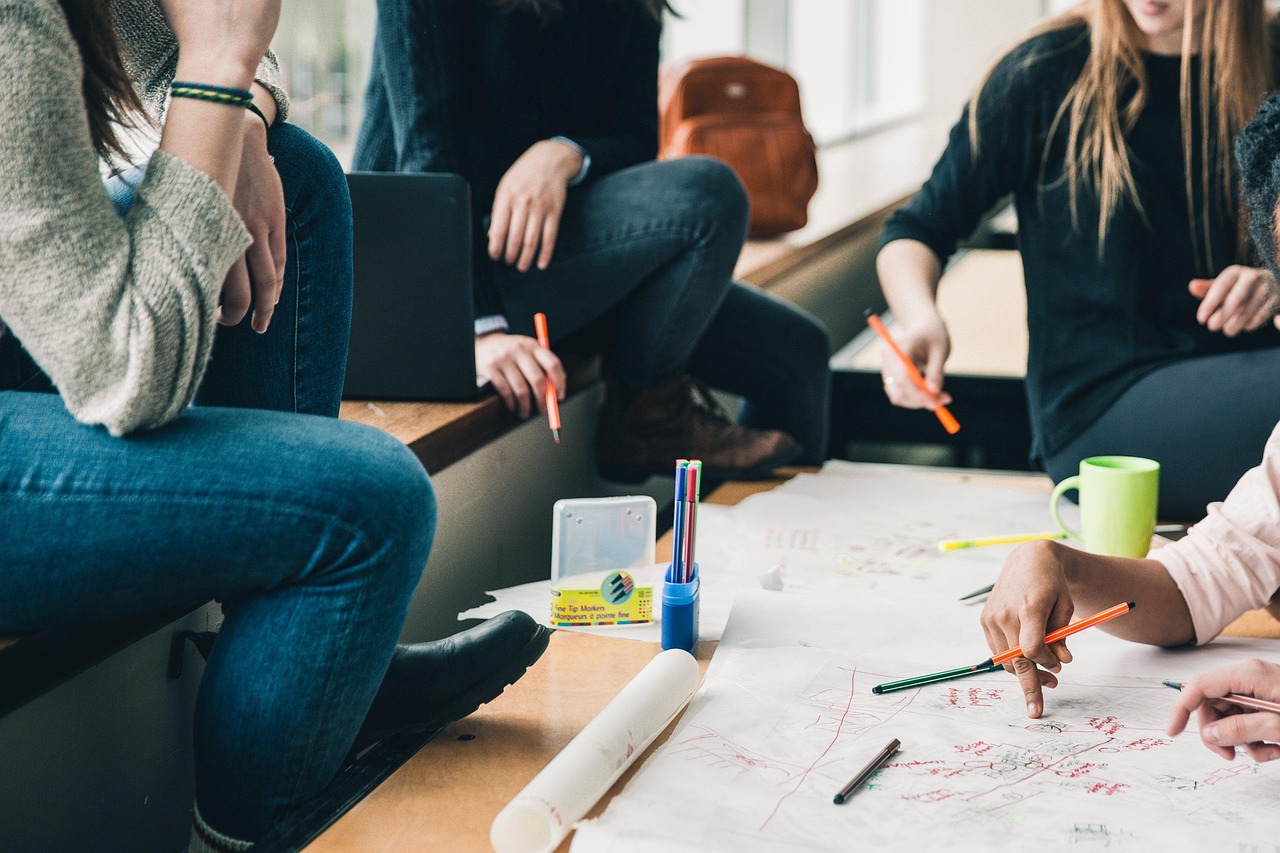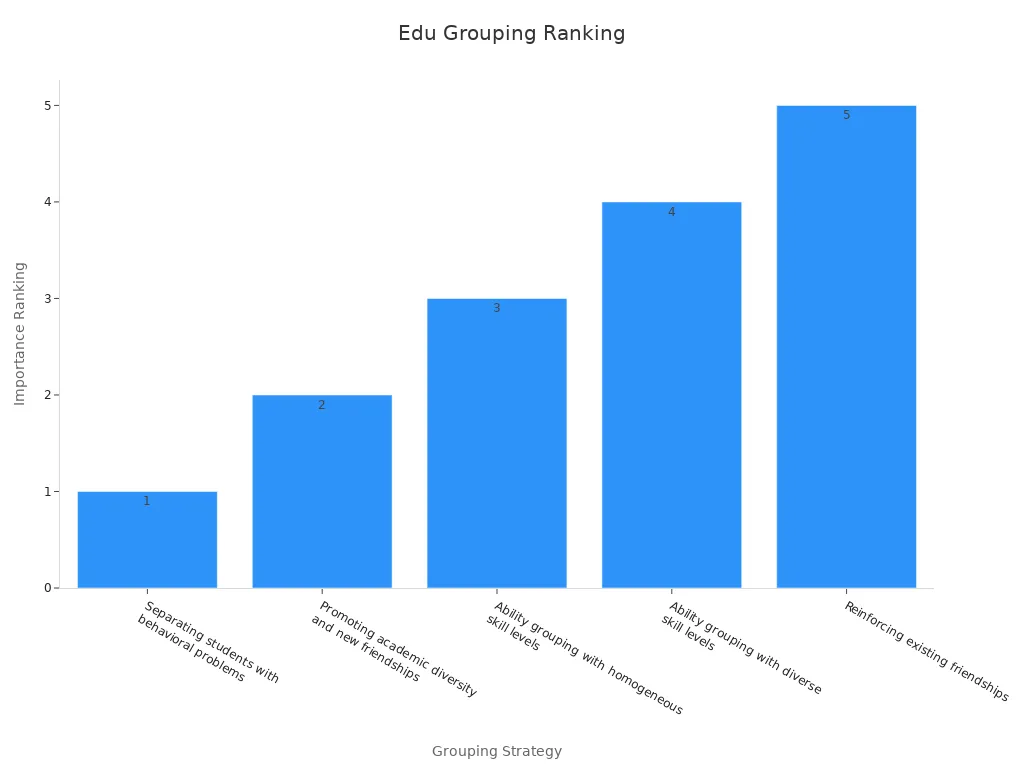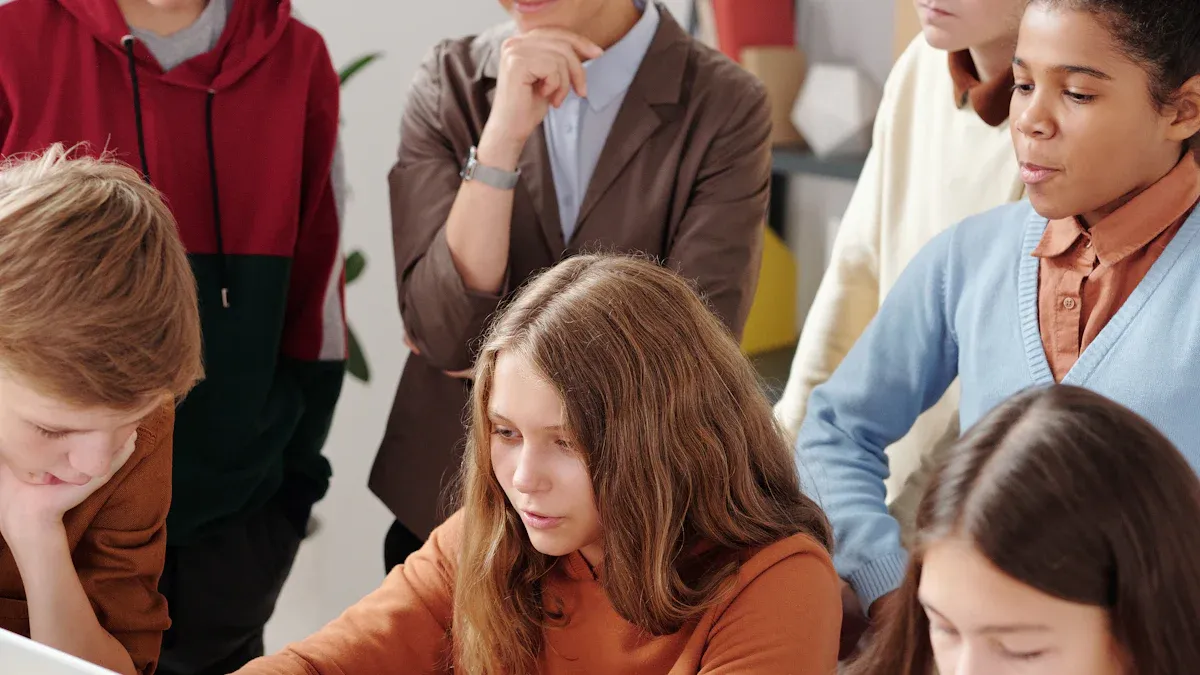
Implementing Collaborative Learning Strategies helps students work together to reach shared goals. These strategies change classrooms by encouraging teamwork, thinking skills, and active involvement. For example, research shows that implementing collaborative learning strategies improves peer support. This greatly increases student interest and motivation. Schools using group-based tools saw problem-solving improve by 72%. Differences in group participation also went down by 68% in one year. These results show how teamwork creates inclusive and lively classrooms.
Working together makes learning more fun and exciting. Team activities can greatly improve how students solve problems.
Clear goals are very important. Specific goals help students know their tasks and focus on group success.
Picking the right groups helps teamwork. Mixing skills and friends makes working together and learning better.
Giving roles in groups builds responsibility. Clear roles show students how they help and improve teamwork.
Thinking back and sharing feedback is key. Asking students to reflect on teamwork helps them learn and get better.
Setting clear learning goals is key to successful teamwork. When goals are specific, students know what to do and how their work helps the group. This understanding builds motivation and keeps activities connected to learning objectives.
They show students steps to succeed.
They help check if teamwork activities work well.
They keep tasks focused and meaningful.
Use these proven methods to make strong learning goals:
Method | What It Means | Why It Helps |
|---|---|---|
Uses planned activities and structure | Improves learning for everyone | |
Matching Tasks to Tests | Links lessons to evaluations | Encourages independent learning |
Clear Expectations | Explains what students need to do | Supports fair teaching and grading |
These methods help students not just join in but also succeed in group work.
Studies suggest ways to better define and check learning goals:
Train teachers to connect teamwork with better teaching and learning (Darling-Hammond et al., 2021).
Build trust so students feel safe sharing ideas (Harris and Jones, 2022).
Use online tools to share ideas and work together (Bermudez and De Vera, 2019).
By using teamwork strategies with clear goals, you create a fair and organized classroom. This helps students do well in school and learn teamwork for future jobs.
Making good groups is key for teamwork to succeed. When groups are planned well, students work better together. This leads to more interest and better results. To do this, think about mixing skills, friendships, and strengths.
Studies show that forming groups carefully is important. Well-made groups do better than regular teaching methods. Badly made groups can hurt teamwork. For example, smart systems using learning data help students stay engaged and improve. This shows how group setup affects teamwork quality.
Evidence Description | Findings |
|---|---|
Smart systems using learning data | Boost student focus and teamwork success |
Well-formed groups in teamwork | Do better than regular teaching |
Poorly made groups | Can harm teamwork and learning |
Machine learning for group setup | Offers flexible and smart solutions |
You can use different ways to make groups based on your goals. Research ranks these methods by how helpful they are:
Grouping Strategy | Importance Ranking |
|---|---|
Keeping apart students with behavior issues | 1 |
Mixing skills and building new friendships | 2 |
Grouping by same skill levels | 3 |
Grouping by mixed skill levels | 4 |
Keeping current friendships | 5 |

Combine students with different skills to help them learn.
Don’t group students who argue often to keep peace.
Use tools or systems to make fair and balanced groups.
By planning groups well, students can do their best in teamwork. Collaborative Learning Strategies work better when groups are made to help everyone join and learn.
Giving each student a role helps everyone take part. When students know their tasks, the group works better. This keeps students interested and makes them feel responsible for their work.
Positive role interdependence is a helpful teamwork method. It gives each student a unique job, so everyone helps the group succeed. For example, one student might be the facilitator, leading talks and making sure everyone speaks. Another could be the recorder, writing down ideas and decisions. These roles improve teamwork and teach skills like leadership and communication.
Role | What They Do |
|---|---|
Facilitator | Leads talks and makes sure everyone shares ideas |
Recorder | Writes down the group’s thoughts and choices |
Materials Manager | Handles supplies and keeps track of time |
Reporter | Shares the group’s work with the whole class |
Fact Checker | Makes sure all information is correct |
Harmonizer | Solves problems and keeps the group working well together |
Switching roles often is a good way to be fair. This helps students learn new skills and try different jobs. Giving role cards with tips can help younger students understand their tasks better.
Studies show that clear roles make groups work better. When students know what to do, they help more and work well together. Using Collaborative Learning Strategies with clear roles makes sure everyone feels included and important.
Tip: Ask students to think about their roles after each task. This helps them see what they did well and what to improve.
By carefully assigning roles, you create a fair and active classroom where all students can succeed.
Organized activities are important for making teamwork successful. Clear steps help students stay focused and work well together. These activities guide teamwork, showing each student how to help the group.
Studies show how organized tasks improve group learning. Brewer and Klein (2006) found that giving roles with rewards made students interact more. But Dillenbourg (2002) warned that too much structure can lower motivation.
Study | Results |
|---|---|
Johnson et al. (2007) | |
Slavin (1991, 1995) | Group rewards are key for good teamwork. |
Serrano and Pons (2007) | Individual grades help teamwork in groups. |
Sears and Pai (2012) | Rewards don’t always change group behavior. |
Hänze and Berger (2007) | Jigsaw groups don’t perform better than working alone. |
Brewer and Klein (2006) | Roles with rewards increase student interaction. |
Dillenbourg (2002) | Too much structure can hurt motivation. |
Use organized tasks to guide students in teamwork. Break big projects into smaller steps to make them easier. Match roles to students’ skills and let them take charge of their tasks. Tools like checklists or timelines can help keep groups on track.
Research shows that active learning works best in supportive classrooms. Teachers who encourage teamwork help students stay involved and learn more.
Organized activities make students feel confident and motivated. This keeps teamwork focused and effective. By mixing clear rules with some freedom, you create a classroom where students work well together.

Good communication and teamwork are key to working well together. When students share ideas, they learn to trust each other. They also get better at solving problems. Using Collaborative Learning Strategies gives students chances to practice these important skills.
Working in groups helps students talk and listen better. It also builds friendships and keeps them interested. Here are some benefits:
Talking in groups helps students share ideas and hear others.
Giving feedback teaches students to trust and help each other.
Doing group presentations improves speaking and teamwork skills.
These activities make students better at talking and ready for real-life challenges.
Studies show that good communication makes teams work better. For example, research found a strong link between talking well and team success:
Connection Type | Value | Importance Level |
|---|---|---|
Motivation from communication | p < 0.01 | |
Link between teamwork and talking | Medium | p = 0.561 |
When teams don’t talk well, problems happen more often. In healthcare, teams with poor communication face five times more issues. This shows how talking well improves teamwork and results.
You can help students talk better by:
Making a safe space where they feel okay sharing ideas.
Using apps or tools to help them talk and work together.
Giving group tasks that need regular talking and planning.
By focusing on talking, students connect better and work as a team.
Tip: Ask students to think about how they talked after each task. This helps them see what went well and what to improve.
Using Collaborative Learning Strategies improves talking and teamwork. These skills will help students in school and their future.
Thinking about teamwork helps students improve their learning. Reflection lets students see what they did well and what needs work. Feedback from classmates and teachers shows them how to get better and feel confident about future tasks.
Reflection helps students think about their own thoughts. Research says reflection builds teamwork skills. For example, student teachers who practiced reflection worked better in groups and met science goals. Teachers can ask questions like, “What went well in your group?” or “What can you change next time?”
Talking in groups or class meetings helps students reflect. These talks let students share ideas and learn from others. Hearing new opinions helps them understand different views and think deeply. Clear rules for respectful talking make these discussions safe for everyone.
Feedback is important for improving teamwork. Peer feedback shows students how others see their work. Teacher feedback gives expert advice and helps them improve. Good feedback focuses on actions, not general praise. For example, instead of saying, “Nice job,” say, “Your problem explanation was clear and detailed.”
Using reflection and feedback builds a classroom where students keep improving. These methods make teamwork better and teach skills for lifelong learning.
Tip: Use journals or apps to help students write reflections and track their progress over time.
Recognizing what students achieve helps them feel proud and motivated. When you celebrate their success, they feel appreciated and want to keep helping their group. This builds their confidence and makes the classroom feel like a supportive community.
There are many ways to show students you value their efforts. These ideas make recognition special and meaningful:
Description | |
|---|---|
Verbal Praise | Say things like, "Great job helping your classmates today!" |
Written Approval | Write kind notes on their assignments or projects. |
Physical Gestures | Smiling or clapping can make students feel happy and encouraged. |
You can also try fun routines like "Friday Shout-outs" to highlight great work. Show off student projects on bulletin boards or share their success with families through notes. These small actions can inspire students to keep trying their best.
Be clear about what you're praising. For example, say, "You did a great job organizing the project," instead of just "Good job."
Focus on how hard they worked, not just their natural talent. This helps students believe they can improve with effort.
Praise them at the right time. Recognize their achievements right away to encourage good behavior.
Tip: Change the student work on display often to keep the classroom exciting and fresh.
By using collaborative learning strategies, you create chances to celebrate both group and individual wins. These celebrations keep students motivated and build a classroom full of teamwork and appreciation.
Checking and improving your collaborative learning strategies helps your classroom grow. By seeing what works and fixing what doesn’t, you can better meet your students’ needs. This makes learning more effective and encourages creativity and progress.
Regular checks show what’s working and what needs fixing. For example, comparing test scores before and after lessons shows how students improve in thinking and decision-making.
Measure | Pre-test Scores | Post-test Scores | Big Improvement? |
|---|---|---|---|
[value] | [value] | Yes | |
Decision-Making Skills | [value] | [value] | Yes |
These results prove that tracking progress helps make strategies better.
Start by gathering information from tests, group work, and student feedback. Use this to think about your teaching style. Studies show that reviewing data often improves teamwork in classrooms. Teachers in groups like Professional Learning Communities (PLCs) find that looking at data helps them see what works and what doesn’t. This helps you adjust your methods and make learning more fun and effective.
Tip: Ask students how they feel about group work. Their ideas can show what helps them and what’s hard for them.
After checking, make small changes to improve your strategies. For example, if students have trouble talking in groups, add activities that teach listening and speaking clearly. Keep reviewing your methods to match your goals. Collaborative learning strategies work best when you keep improving them based on real results.
By checking and improving your methods, you create a classroom where everyone can do their best.
Collaborative learning turns classrooms into places where students do well. These methods help students think critically, work in teams, and stay involved. They also prepare students for future challenges. Studies show their success with clear results. For example, Teach For Nigeria found students learned 2-5 extra months of math and reading. Teach For Pakistan showed big improvements in English, math, and science. Enseña por México reported better social and emotional skills, showing teamwork’s wide benefits.
Start small when trying collaborative learning strategies. Test different ideas and adjust them for your class. Teach students to work together and respect different opinions. By building teamwork skills, you help them succeed in school and life.
Collaborative learning strategies are ways to help students work together. These include group talks, giving roles, and planned activities. They build teamwork, better communication, and critical thinking skills.
Start by making clear goals and creating fair groups. Give each student a role and use planned tasks to guide teamwork. Begin with small steps, try different ideas, and adjust as needed.
Online tools like Google Workspace or apps like Padlet are useful. They help students share ideas, work on projects, and stay organized during group tasks.
Teach students to talk openly and solve problems calmly. Assign a "harmonizer" to help fix arguments. If problems continue, step in to guide the group and keep things positive.
Yes! Studies show it helps students think critically and solve problems. Working in groups also keeps students interested and improves their grades.